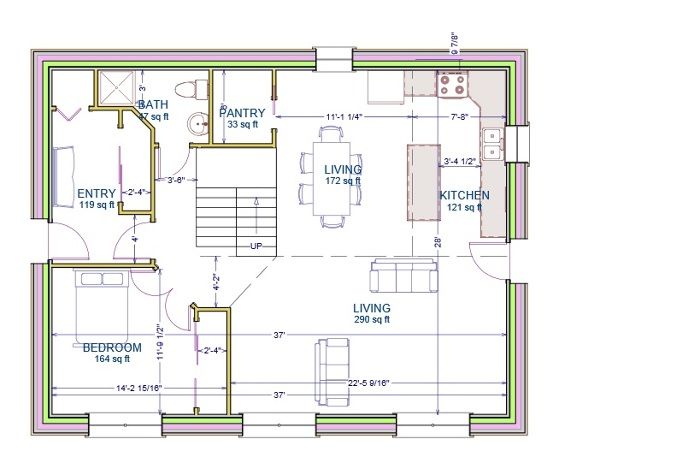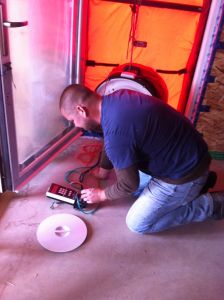
Beth and Ralph Peters and their four children have just passed the one-year mark in their new Passivhaus home on Prince Edward Island, and can report their energy-saving efforts have more than paid off. The total heating bill for the year, all 754kwh worth of it, was $99.23.
That’s pretty good for an area that sees about 8000 heating degree days a year.
The Peters family house, built to the Passivhaus standard, might have been the first to be certified on PEI had they pursued formal certification. The $5000 plus cost of certifying the house was more than their budget allowed, but they’ve been reaping the rewards nonetheless.
They turned the heat on for the first time this season in November, Beth Peters explained in a blog called Long River House.
“Ugh, I did not want to make this post but, alas, we have had to turn the heat on,” she wrote. “And by heat I mean our one 1500w heater.”
Making plans for a new home
The Peters first spotted the property on which they would eventually build about 10 years ago. The parcel is in the town of Long River, the same community where they had been living and where they wanted to stay.
“It is a total of seven acres and is surrounded on three sides by trees, which should offer us good protection from the wind,” she wrote. “It is also the last property on a paved road and is much quieter than the road we used to live on.”
The Peters didn’t immediately decide to go the Passivhaus route, but they were interested in energy-efficiency and when they began poking around that topic, trying to meet the Passivhaus standard became more appealing. They also recognized they’d need some serious design help, so they contacted Garth Hood of Thoughtful Dwellings, a certified Passivhaus consultant in neighboring New Brunswick.
“I think there might be a Passivhaus consultant on the island now,” he said recently by phone, “but at the time I was the only game in town so they went with me.”
Hood designed the house as well as carried out the energy modeling, a dual role he says he took out of necessity.
“I’ve yet to find a designer in New Brunswick that understands how to design an energy-efficient house,” he said. “I started my work just doing the energy modeling part, but it was such a hassle for me to redesign houses that I just started designing them. You don’t come to me if you want a California roof. I just don’t do that, and those clients leave very quickly. I tend to design with Passivhaus first and foremost in mind, so they tend to be boxy houses. If they want interest we tend to put on porches and things.”
By February 2014, Hood and the Peters were close to completing the plans.
“It has been really tough poring over plans,” Beth wrote. “How do we cram everything we want into our box?”
But cram they did, and in the end the family managed to get what they wanted in 1950 sq. ft., a house that might seem tight for a family of six.
An early encounter with energy modeling
By April, the project was far enough along to dive into the energy modeling, and the numbers stunned the Peters.

Exterior walls are 21 in. thick and insulated with dense-pack cellulose.
The Passive House Planning Package Hood was using to design the house gave an energy credit of 100w for each person living in the house, Beth wrote, adding up to an extra 600w of free energy in winter.
“So, with all this taken into consideration our estimated additional required energy is 187w,” she wrote, “187w!! That’s not much! As a comparison the numbers are calculated as well for a house build to code; that came in at a whopping 8628w! So what does this really equate to? Well, if we were to run a 187w heater for 24 hours a day, 7 days a week, for 150 days a year that would work out to be $81.46!!! On the contrary, if I did the same calculation for a code built house my bill would come in at $3758.35 … wow!”
Another way of looking at it, she added, was that in the old house they were renting at the time, the bill for a single delivery of oil would be enough to heat their new home for 11 years.
They were hooked.
“The best part of it all (besides saving money) is that we are conserving energy and still living comfortably,” the blog says. “Saving money and helping to save the planet, sounds like a match made in heaven to me.”
Construction details
Builders from Prince Edward Island, Terry and Natalie Perry of Trout River Homes, got some pointers on Passivhaus construction from Tim Naugler in New Brunswick, with whom Hood had worked with before. To save money, they skipped a full set of construction drawings.
Builders broke ground on July 8, 2014, beginning with site preparation for the 6-in.-thick layer of Type II expanded polystyrene insulation that would insulate the slab. Slab edges are insulated with 12 in. of EPS.
Other details:
- Exterior walls: The 21-in.-thick walls are comprised of a structural 2×6 assembly and an outer 2×4 joined with webs of OSB. Between the 2×4 and 2×6 bottom plates is a 6-in. space, and on the inside of the 2×6 wall there is a non-structural 2×4 service wall. All cavities are filled with dense-pack cellulose to R-60. Wood siding was installed over a vented rain screen.
- Roof: Raised-heel trusses insulated with loose-fill insulation to R-74.
- Ventilation: A Zehnder ComfoAir 350 heat-recovery ventilator provides fresh air for the house. What the blog describes as a “poor man’s geothermal“ system, a 500-ft.-long tube filled with glycol and buried 6 ft. in the ground, tempers incoming air in the HRV.
- Domestic hot water: Tank-style electric.
- Windows: Klearwall uPVC triple-glazed tilt-and-turn windows manufactured in Ireland. Windows are set at about the midpoint of the wall.
- Air leakage: In exterior walls, the air barrier is a layer of taped OSB just to the outside of the 2×4 service wall; in the roof a membrane made by Mento is the air barrier. A blower-door test measured air leakage at 0.21 air changes per hour at a pressure difference of 50 Pascals.
- Energy use: Total energy use during the first year of occupancy was 10,029kwh, which includes 4741kwh in household electricity, 4534kwh for the water heater and 754kwh for the electric heating element. A spreadsheet showing monthly energy use is posted at the blog.
There currently are no renewable energy systems in the house, but the couple plans to add photovoltaic panels once they’d been in the house long enough to size the array correctly. The couple didn’t divulge construction costs.
The family moved into their new home in February, 2015.
No certification is planned
Hood thinks the house is close to meeting the Passivhaus standard, but the cost of going through the certification process was enough to deter the Peters from trying.
“They were talking about certification until we got to all the costs that would be involved,” Hood said, “and then the conversation dropped off.” He estimated costs at a minimum of $5000, and possibly as high as $7500.
“I can’t say for sure they would meet the Passivhaus standard,” he said, “but they are very, very, very close.”
Is it something the Peters might want to pursue in the future?
“Probably not,” Beth replied in an email. “It is an added cost (which is significant) that we would prefer to put into something like solar electric.”
If the family had the project to do again, Beth said, they would turn the small, covered deck on the west side of the house into an insulated mudroom outside the thermal envelope of the house and put the washer and dryer there.
“Most of the time is not an issue not having a dryer in the house, but we do miss the convenience of it sometimes,” she wrote. “Hopefully, it won’t be too long and heat pump dryers will be readily available Overall, we are extremely happy with the design and functionality of the house. It works perfectly for our family.”
Read more: http://www.greenbuildingadvisor.com/blogs/dept/green-building-news%2A#ixzz43XpmxUfl
Follow us: @gbadvisor on Twitter | GreenBuildingAdvisor on Facebook
Fine Homebuilding Recommended Products
Fine Homebuilding receives a commission for items purchased through links on this site, including Amazon Associates and other affiliate advertising programs.

Handy Heat Gun

8067 All-Weather Flashing Tape

Reliable Crimp Connectors




























View Comments
Would you clarify how the 1950 sq ft is calculated? If it's at the perimeter of the building the usable sq footage will be considerably less.